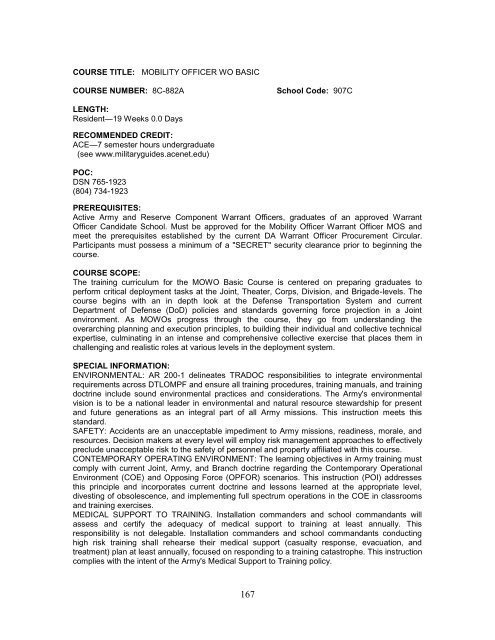FORWARD - Army Logistics University - U.S. Army
FORWARD - Army Logistics University - U.S. Army
FORWARD - Army Logistics University - U.S. Army
Create successful ePaper yourself
Turn your PDF publications into a flip-book with our unique Google optimized e-Paper software.
COURSE TITLE: MOBILITY OFFICER WO BASIC<br />
COURSE NUMBER: 8C-882A School Code: 907C<br />
LENGTH:<br />
Resident—19 Weeks 0.0 Days<br />
RECOMMENDED CREDIT:<br />
ACE—7 semester hours undergraduate<br />
(see www.militaryguides.acenet.edu)<br />
POC:<br />
DSN 765-1923<br />
(804) 734-1923<br />
PREREQUISITES:<br />
Active <strong>Army</strong> and Reserve Component Warrant Officers, graduates of an approved Warrant<br />
Officer Candidate School. Must be approved for the Mobility Officer Warrant Officer MOS and<br />
meet the prerequisites established by the current DA Warrant Officer Procurement Circular.<br />
Participants must possess a minimum of a "SECRET" security clearance prior to beginning the<br />
course.<br />
COURSE SCOPE:<br />
The training curriculum for the MOWO Basic Course is centered on preparing graduates to<br />
perform critical deployment tasks at the Joint, Theater, Corps, Division, and Brigade-levels. The<br />
course begins with an in depth look at the Defense Transportation System and current<br />
Department of Defense (DoD) policies and standards governing force projection in a Joint<br />
environment. As MOWOs progress through the course, they go from understanding the<br />
overarching planning and execution principles, to building their individual and collective technical<br />
expertise, culminating in an intense and comprehensive collective exercise that places them in<br />
challenging and realistic roles at various levels in the deployment system.<br />
SPECIAL INFORMATION:<br />
ENVIRONMENTAL: AR 200-1 delineates TRADOC responsibilities to integrate environmental<br />
requirements across DTLOMPF and ensure all training procedures, training manuals, and training<br />
doctrine include sound environmental practices and considerations. The <strong>Army</strong>'s environmental<br />
vision is to be a national leader in environmental and natural resource stewardship for present<br />
and future generations as an integral part of all <strong>Army</strong> missions. This instruction meets this<br />
standard.<br />
SAFETY: Accidents are an unacceptable impediment to <strong>Army</strong> missions, readiness, morale, and<br />
resources. Decision makers at every level will employ risk management approaches to effectively<br />
preclude unacceptable risk to the safety of personnel and property affiliated with this course.<br />
CONTEMPORARY OPERATING ENVIRONMENT: The learning objectives in <strong>Army</strong> training must<br />
comply with current Joint, <strong>Army</strong>, and Branch doctrine regarding the Contemporary Operational<br />
Environment (COE) and Opposing Force (OPFOR) scenarios. This instruction (POI) addresses<br />
this principle and incorporates current doctrine and lessons learned at the appropriate level,<br />
divesting of obsolescence, and implementing full spectrum operations in the COE in classrooms<br />
and training exercises.<br />
MEDICAL SUPPORT TO TRAINING. Installation commanders and school commandants will<br />
assess and certify the adequacy of medical support to training at least annually. This<br />
responsibility is not delegable. Installation commanders and school commandants conducting<br />
high risk training shall rehearse their medical support (casualty response, evacuation, and<br />
treatment) plan at least annually, focused on responding to a training catastrophe. This instruction<br />
complies with the intent of the <strong>Army</strong>'s Medical Support to Training policy.<br />
167



